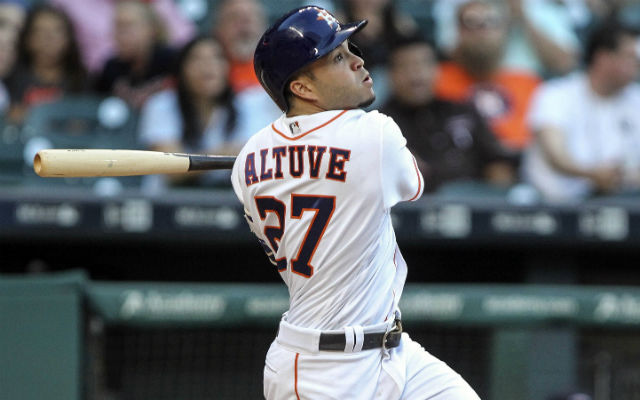Here’s why Jose Altuve is one of the oddest hitters in baseball – CBSSports.com
All the advanced metrics agree: Jose Altuve has been the most productive hitter in the American League. He entered Mother’s Day ranked first in OPS+, True Average, and wOBA, as well as first in extra-base hits and second in home runs — incredibly, his nine homers are already the second-most he’s hit in a season.
Such harmony is difficult to find when it comes to more subjective titles — say, baseball’s oddest hitter — but Altuve’s case for that crown is as strong as any — and has been for years.
When you think about a true-talent .300 hitter — and Altuve, who won the batting title in 2014, is that — you probably envision someone with impeccable bat control; someone who can spray line drives from foul line to foul line; perhaps someone who pokes the ball through the holes in the infield. Likewise, when you put together a mental image of a pull hitter, you might land on the oafish, low-average slugger who gets shifted to near-death — only his thump and plate discipline delay his extinction.
Therein is the conflict that makes Altuve an oddball: he’s a stylistic contradiction. Prior to this season, he’d never bothered with power or walks: his .342 ISO is higher than the sum of his previous three efforts, and his 15 walks in 138 plate appearances puts him nearly halfway to his single-season best in about a quarter of the tries. Yet even so, Altuve has been one of the game’s finest pull hitters.

Since 2014, Altuve’s pull rate (more than 40 percentage of his balls in play) is the fifth-highest among second basemen, per FanGraphs. Naturally, the opposition has countered this trend with defensive shifts — such as moving three infielders to the third-base side of Altuve’s keystone position. What those teams have learned is the exaggerated positioning doesn’t work. Last season Altuve hit .371 against shifts, and it’s easy to figure why: he’s an above-average runner who can beat out throws from deep in the hole — or, in certain cases, from weak-armed second basemen who are on the far side of the bag.
Altuve has grown more unusual in 2016. In addition to the altered performance, Altuve has morphed his approach. He’s swinging and expanding his strike zone far less often than normal, all the while making less contact. Predictably, those changes have led to longer at-bats. Whereas Altuve entered the season having seen 3.23 pitches per plate appearance, so far he’s up to 3.72 per — ratio below the league-average, yet a difference that results in some 325 additional pitches per season.
Established hitters seldom change their games to this extent. As such, pegging Altuve’s future is tougher than it seems. Or maybe it’s not. He’s unlikely to keep up his current pace — such is the case for anyone hitting .317/.406/.658 — but you can bet on certain things. For instance, that Altuve will remain a productive hitter and a bright spot amid a dim Astros season. Oh, and this — that his success will hardly make sense along the way.



